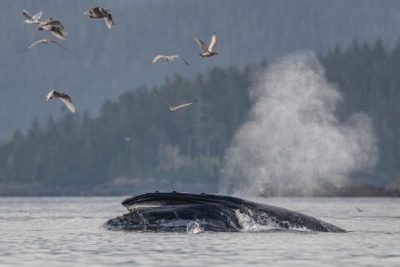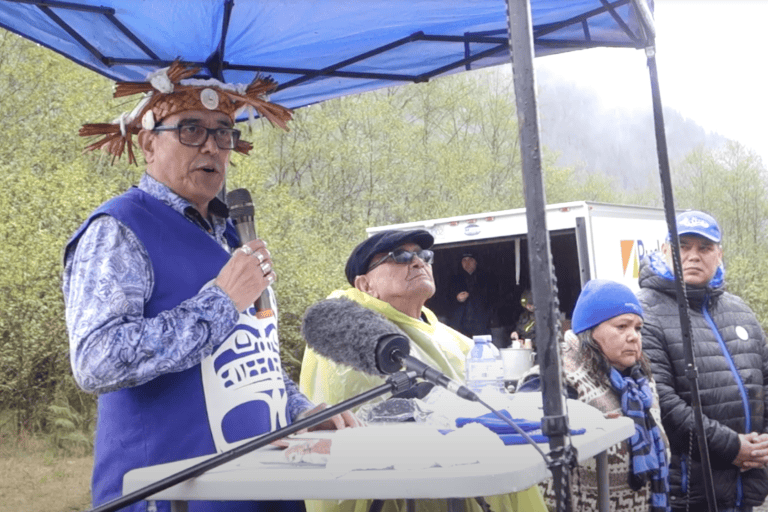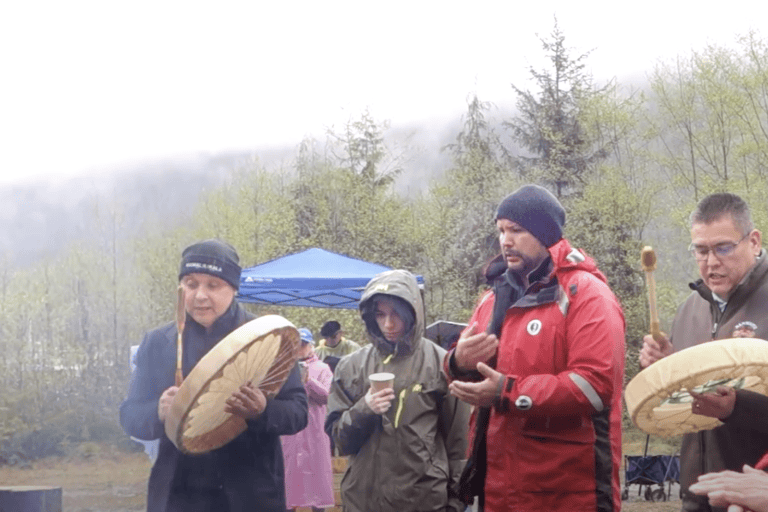First Nation Reclaims Territory by Declaring Indigenous Protected Area in Canada

All Global Research articles can be read in 51 languages by activating the “Translate Website” drop down menu on the top banner of our home page (Desktop version).
To receive Global Research’s Daily Newsletter (selected articles), click here.
Visit and follow us on Instagram, Twitter and Facebook. Feel free to repost and share widely Global Research articles.
***
Persistent rain couldn’t dampen the high spirits of Mamalilikulla First Nation members and their guests on a dark day in May. As lowering clouds played hide-and-seek with soaring mountains, the Nation shared lunch and performed traditional songs and dances in their remote territory on British Columbia’s Central Coast, some 350 kilometers (220 miles) north of Vancouver.
The festive event was to dedicate this place as the Gwa̱xdlala/Nala̱xdlala (Lull Bay/Hoeya Sound) Indigenous Protected and Conserved Area. Chief Councilor John Powell (Winidi) said it was the first time in more than a century that these songs, these dances had been performed here.
The Mamalilikulla people lived in this rugged area and parts of the Broughton Archipelago for millennia before Europeans arrived. Over the course of the 20thcentury, band members, who now number around 441, moved from their land to cities and towns throughout western Canada, including Victoria and Vancouver. In 1972, the last people left the last village of ‘Mimkwa̱mlis on Village Island, about 40 minutes by boat from Gwa̱xdlala/Nala̱xdlala. Meanwhile, the government of British Columbia leased the land to logging companies, which clear-cut forests, causing landslides that silted up streams and harmed salmon. The government of Canada issued fishing permits in the coastal waters, allowing damaging practices such as trawling and long trap lines, which continue today.
The Nation declared the Indigenous Protected and Conserved Area (IPCA) in November at the Royal B.C. Museum in Victoria, British Columbia, proclaiming its intent to take a primary role in planning, use, management and restoration of the land and water. It plans to also reconnect dispersed band members with their land and create economic enterprises for the Nation, such as wildlife-viewing tourism.
This declaration has been acknowledged by federal and provincial officials, but it remains to be seen whether and to what extent those governments might relinquish authority. The province has established a working group to discuss management plans with the Nation.
As we approached the site of the May ceremony by boat, a black bear picked clams along the beach. The designation covers a 10,416-hectare (25,738-acre) area from the top of the mountains down into the sea. The river watersheds are home to western hemlock, yellow cedar and mountain hemlock; chum, coho and pink salmon; grizzly and black bear; and other species. The marine portion contains Hoeya Sill, home to rare shallow sponges and corals that are particularly at risk from fishing practices.
Like many First Nations in British Columbia, the Mamalilikulla never signed a treaty and considers its land and waters unceded. The IPCA site includes evidence of the Nation’s history of occupation, including village sites, fish traps, shell middens, petroglyphs and culturally modified trees. In fact, the Nation petitioned for Gwa̱xdlala/Nala̱xdlala more than a century ago under the Indian Reserve program and was denied. It is currently involved in legal discussions about that decision.
“The IPCA Declaration is a constructive challenge to Canada and B.C. to advance reconciliation efforts with the Mamalilikulla, and to honor … their commitments to the United Nations Declaration on the Rights of Indigenous Peoples,” Chief Powell said. “It is an invitation to commence negotiations on a co-governance agreement for the Gwa̱xdlala/Nala̱xdlala (Lull and Hoeya) watersheds.”
Declaring an IPCA in various forms — tribal parks, Indigenous cultural landscapes, conservancies — is a growing strategy by Nations across Canada to reclaim care for their traditional lands. The big question underlying these declarations is who will actually make decisions and have the authority to enforce them.

Chief Powell speaks before the event dedicating the land as the Gwa̱xdlala/Nala̱xdlala (Lull Bay/Hoeya Sound) Indigenous Protected and Conserved Area. Image courtesy of Erica Gies.
Chief Powell’s use of the word “co-governance” is significant, conveying sovereignty and self-determination. The province and federal governments instead typically use co-management, a term that retains their authority and that some First Nations view as treating them like one of various stakeholders, on a par with fishing and logging interests, conservationists, and the general public.
“We’re not stakeholders,” Chief Powell said. “We’re the owners.”
More than 240 marine animals to protect
There are imminent fishing threats to the area called Hoeya Sill, home to more than 240 species of ocean animals and rare corals and sponges. On the day of the ceremony, the 40-day prawn season opened, soon to be followed by the longer crab and shrimp seasons. Prawn fishers use long lines studded with traps that can catch on the corals, breaking them. The other fisheries can also cause harm via long lines and trawling.
Although the federal department of Fisheries and Oceans Canada (DFO) has identified Hoeya Sill as a potential area to protect, by several accounts, it seems unwilling to deviate from its slow processes, even to establish a temporary moratorium.
“DFO is still the Britannia that rules the waves,” said John Bones, a consultant to the Nation. “It’s got that feel. This is the way they do things, and they’re not prepared to change their system to accommodate First Nations.”
Chief Powell characterized the DFO as “nonresponsive or even evasive,” citing his multiple meeting invitations extended to Rebecca Reid, the DFO’s director-general for the Pacific region.

Humpback whale off the coast of British Columbia, Canada. Image courtesy of Anthony Bucci.
The DFO would not make someone available to speak with Mongabay either. In an email, the department said it was aware of the declaration and intends further discussion on measures to protect the Gwa̱xdlala/Nala̱xdlala site.
Meanwhile, fishing continues. And the province of British Columbia retains tenures in Gwa̱xdlala/Nala̱xdlala for logging, commercial recreation, trapping, and fishing.
The Mamalilikulla have created a management plan for both the marine and freshwater areas, with acceptable and unacceptable uses, and want theirs to be the final authority. They are reinstituting their Kwak’wala language place names and conducting baseline measurements for streams, fish, grizzly bears, habitat conditions, culturally important plants, archaeological sites, and traditional foods. The plan withholds support for logging for five years while the Mamalilikulla develop a long-term management strategy.
In the absence of engagement with federal officials, the Nation erected a “No fishing” sign over Hoeya Sill. It also reached out directly to fishing groups, asking them to spare the sill during the current season.
Although the prawn industry organizations are open to possible protections, said Jim McIsaac, coordinator of the B.C. Commercial Fishing Caucus, the Nation’s request, in March, came too late to be implemented for the start of this season.
The Mamalilikulla, like many coastal First Nations, also have a Guardian program, in which Nation members patrol waters where DFO boats are largely absent. They carry moral authority that they hope people will respect — and the possible threat of legal action, if the Nation can afford to bring it.
“It’s one thing to create an IPCA and another thing to enforce it and have some jurisdiction to do so,” said former chief councilor Richard Sumner, who helped begin the process of creating the IPCA. “Our guys can’t arrest people. All they can do is monitor and report. And inform. This is one of the big things we’ve got to do in all of our Nations: let the public know what is acceptable in our territories.”
Sometimes it works. When the Mamalilikulla found out that logging companies planned damaging log dumps near the area of the ceremony, it appealed to them directly.
Chief Powell recounted talking to the forester: “‘Why would we declare an IPCA and after allow a log dump? No, it’s not acceptable. You need to move the log dump.’ And industry agreed to do so.”
Conservation Canadian style
Canada has its own conservation initiatives, including a commitment to the international Convention on Biological Diversity (CBD), that requires protecting 25% of land and oceans by 2025 and 30% by 2030. But some conservationists have questioned the efficacy of its protected areas because various industrial activities are still allowed: fishing, mining, dumping, oil and gas development. In response to public outcry a few years ago, Canada strengthened its criteria but still has a ways to go to effectively protect biodiversity, critics say.
Proponents for Indigenous-led conservation say Indigenous management could yield better results. An international study showed that biodiversity is higher on the 25% of land managed or owned by Indigenous peoples. That may be partly due to Indigenous groups’ tendency to manage whole ecosystems, rather than focus on specific species. This is why groups such as the Mamalilikulla argue that they can help Canada meet its conservation commitments.

Orcas off the coast of British Columbia, Canada. Image courtesy of Anthony Bucci.
“The evidence of how successful [the Mamalilikulla’s laws] were,” Chief Powell said, “is the fact that when Europeans came here, everything was so plentiful. Now we find ourselves in this situation,” alluding to the current degraded state of the land and water.
Along the West Coast, both British Columbia and Canada have consulted with First Nations, including the Mamalilikulla, to plan a network of marine protected areas down the coast and for forest management under the Great Bear Rainforest Land Use Order, a much-touted conservation deal struck in 2016.
However, the DFO paused marine network planning in the fall due to “the complexity and scale” of proposed fisheries management, according to the department, “as they are inconsistent with the Department’s regulatory and policy frameworks.” But before that, the collaboration process left the Mamalilikulla somewhat frustrated, Bones said, because the Nation wasn’t given enough time to make decisions about which fisheries would be acceptable or not, and criteria did not include cultural objectives. At the same time, some of the discussions seemed to indicate support for co-governance and First Nations declaring IPCAs.
Different worldviews
Finding common ground could be difficult due to the cultures’ fundamentally different worldviews. Settler governments see fish, trees and minerals as valuable resources, and their economic system incentivizes overexploitation. For that reason, Western conservation has typically focused on regulating human consumption of a single species at a time to keep it from going extinct.
Many Indigenous worldviews instead look at the ecosystem holistically, focusing on the relationships among water and rock, plants and animals — including humans, who they understand to be part of nature.

Mamalilikulla First Nation shared lunch with guests and performed traditional songs and dances in their remote territory on British Columbia’s Central Coast. Image courtesy of Erica Gies.
Chief Powell said the Mamalilikulla’s management plans for the IPCA are based on the ancient law of Aweenak’ola, meaning, “I am one with the Land, the Sea, the Sky and the Supernatural Ones.” For example, Chief Powell laments how settlers log old cedars, where grizzly bears den, focusing only on the trees’ market value and giving “no consideration of the value to a bear.”
As a 2018 report by the Indigenous Council of Elders puts it, conserved areas are less an assertion of rights than an exercise of responsibility.
Because of this focus on interconnections, Indigenous peoples don’t see the same jurisdictional boundaries that hamstring settler governments’ conservation efforts. For instance, Canada’s federal government manages most ocean waters, while two different provincial departments manage forestry and freshwater streams. It’s difficult to ensure ecosystem health with such siloed management.
“That’s why our MPA [marine protected area] is different,” Bones said. “Ours is marine and watershed, from the depth of water to top of the mountain.”
Former chief councilor Sumner agreed that settler management had left the land and waters in a bad state. “Historically there were tens of thousands of salmon in one of those creeks; now there’s absolutely nothing,” he said. The Mamalilikulla aim to restore the watershed and reintroduce fish to rebuild the runs, “not only for ourselves, but also for the grizzly bears. They’re starving to death.”
Many coastal First Nations consider grizzly bears to be kin, so there’s a spiritual aspect to protecting them — but also an economic one. “The benefits of tourism are huge if we have a pristine area where we can have healthy bears,” Sumner said, “and create jobs for our people.”
Many generations of intimacy with this land give Indigenous people an innate awareness of what the land needs, Chief Powell said. “I know we’re at a tipping point right now” due to settler management that prioritizes tax dollars and licensing fees, he said. “But rather [than] do something to resolve it, they pretend it’s not happening, they keep issuing licenses, and defending it. They could care less if we have salmon here. Most of them don’t eat salmon in Ontario. They could care less if our grizzly bears are starving.”
Working together
The two relevant provincial ministries — land, water and resource stewardship, and forestry — signed a letter of intent at the end of April that would establish a “Collaborative Management Working Group with the Mamalilkulla First Nation.”
Sarah Fraser, an assistant deputy minister at the British Columbia Ministry of Forests, spoke at the dedication ceremony. She invoked the province’s action plan under the U.N. Declaration on the Rights of Indigenous Peoples, and its engagement with First Nations to defer additional harvests of old-growth forests until partners agree to management plans.
“These commitments point us toward the type of work we’re beginning with the Mamalilkulla today,” she said. “I support the Gwa̱xdlala/Nala̱xdlala Aweenak’ola collaborative management project.”
British Columbia has made financial commitments to the Nation, and Chief Powell said he’s pleased with the province’s openness to working together. But “I haven’t heard them say ‘co-governance.’ I think they’re being directed not to say that.” He added, “In our own minds, that co-governance is a step toward sovereignty.”
According to Charlie Short, executive director of regional operations for the province’s Ministry of Land, Water and Resource Stewardship, the province has made big strides in its relationships with First Nations. He points to “joint plans, shared objectives” with the Great Bear Rainforest and the marine spatial planning process. Short studied marine ecology and said he’s excited about the potential to manage the land and sea together.
The province is approaching these discussions with a government-to-government lens, he told Mongabay, working first “with the Nation to then engage with other stakeholders and the public.”
However, an email statement from the provincial Ministry of Forests in response to Mongabay’s request for an interview described an approach to the IPCA that reads as co-management.
“Our preferred approach for creating an IPCA is through the Land Use Planning process, as this process ensures that economic, environmental, social, and cultural objectives are met and that robust consultations with Indigenous peoples, stakeholders and the public are included,” it read.
Bones, who worked for the province for nearly 30 years, said, “We are working with good people, but they can’t get ahead of the government policy. We’re working with them to explore the boundaries.”
Back at the ceremony, a bonfire burned on through the rain, while people chatted and joked with relatives they hadn’t seen in a long while. As Chief Powell thanked community members, elders, hereditary chiefs, elected councilors, chiefs of neighboring nations, supporters, and guests for marking “this symbolic occasion on our collective journey,” he choked up.
Finally, after a century’s separation from Gwa̱xdlala/Nala̱xdlala, the Mamalilikulla have claimed it back and aim to repair the damage it has suffered. Through this work, the Mamalilikulla people will reconnect themselves with land, sea, and sky, he said, and will cultivate a place where the animals can feel safe again.
*
Note to readers: Please click the share buttons above or below. Follow us on Instagram, Twitter and Facebook. Feel free to repost and share widely Global Research articles.
Erica Gies is an independent journalist, National Geographic Explorer, and author of the new book Water Always Wins: Thriving in an age of drought and deluge, which follows innovators in what she calls the Slow Water movement, learn more at https://slowwater.world.
Featured image: Humpback whales off the coast of British Columbia, Canada. Image courtesy of Anthony Bucci.

